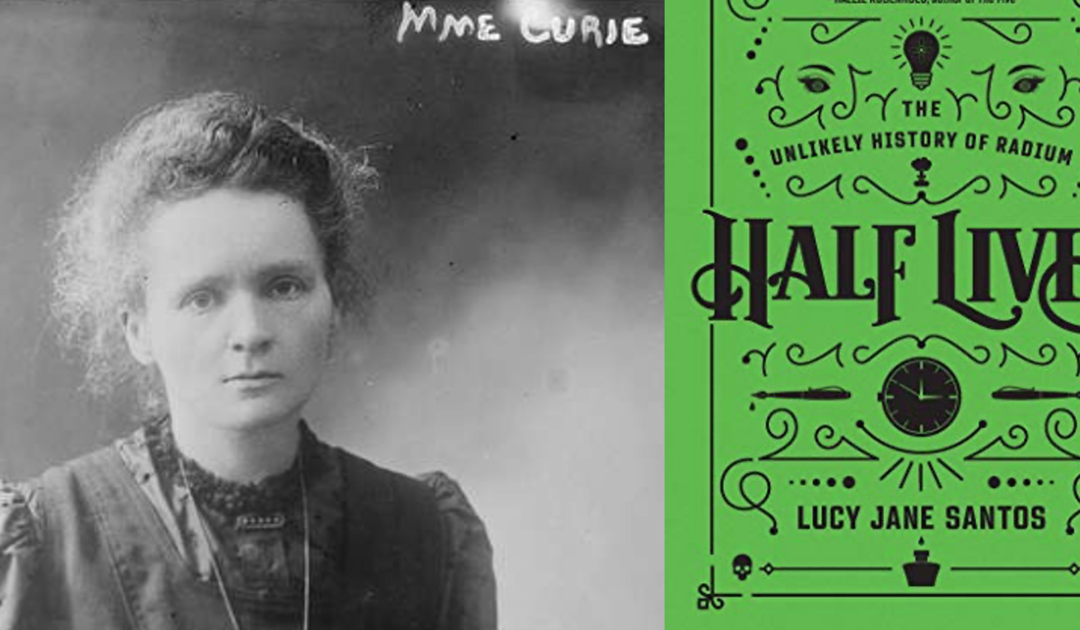by
_____
“My beautiful radium,” she called it.
Marie Skłodowska Curie and her husband spent four years extracting radium from a load of ore found in a mine in Bohemia, then published their discovery at the French Academy of Sciences. She became the first woman to receive a Nobel Prize — not once, but twice, in separate categories, physics and chemistry, both connected to her work on the element radium.
A new book, Half Lives: The Unlikely History of Radium, by British historian Lucy Jane Santos, tells the story of radium and its shape-shifting identity as a revered and prized luxury item, a medicinal cure-all, a commercial bonanza to marketers and hucksters, and one of the world’s most feared, valued, and misunderstood substances.
It’s also, in part, the remarkable story of the Marie Curie.
Radium made her one of the world’s most famous people and a feminist icon — shattering expectations of how a woman should behave and what she could accomplish.
But the real Marie Curie was so full of contradictions and quirks that she defies categorization.
Painfully shy and reluctant to step in the limelight, she did not hold herself up as an example for women, or anyone else. She almost never wrote for the popular press. Only infrequently and reluctantly did she speak in public.
When she won her first Nobel Prize in 1903, she declined to give an acceptance speech. Initially, the Nobel committee did not want to include her in the prize, but her husband Pierre Curie fought for her to be recognized — as indeed she ultimately was. But she chose to stay at home in Paris while her husband and fellow prize recipient Henri Becquerel traveled to Stockholm, and they both delivered lectures there.
By the time Marie Curie was awarded her second Nobel Prize in 1911, her husband had passed away. She did deliver a brief “banquet speech” on December 10, and a longer, highly-technical and scientific award speech the following day. In those remarks, she paid tribute to her husband’s work and affirmed her own accomplishments:
“Some 15 years ago the radiation of uranium was discovered by Henri Becquerel,” she said, “and two years later the study of this phenomenon was extended to other substances, first by me, and then by Pierre Curie and myself.”
With those three little words — “first by me” — she claimed credit where it was due.
With those three little words — “first by me” — she claimed credit where it was due.
But Curie never regarded herself as a symbol or advocate or spokesperson for anything other than pure science. It was her nature to be private, even reclusive.
However, there was one period when she did step into the limelight. During the spring and early summer of 1921, she was at the center of a whirlwind publicity campaign in the U.S.
That’s because despite her worldwide renown, Curie constantly struggled to get the resources she needed for her research. By refusing to patent her method for extracting radium from pitchblende ore, she had given up considerable riches in favor of public ownership of the knowledge.
But the materials she relied on — especially radium — came at a steep price. In 1920, one gram of radium sold for $100,000. As Curie herself noted, radium was “more than a hundred thousand times dearer than gold.”
So in 1921, the magazine editor and socialite Missy Meloney orchestrated on Curie’s behalf a seven-week fundraising tour across the US.
When Curie sailed into New York harbor aboard the USS Olympia on May 11, along with her daughters Irène and Eve, throngs of admirers and photographers were on hand to greet her. A large ad in the New York Times welcomed her to America.
Curie’s schedule over the following weeks was hectic and exhausting. She attended a luncheon on her first day at the home of Mrs. Andrew Carnegie. She appeared at the American Museum of Natural History, where an exhibit commemorated her discovery of radium. The American Chemical Society, the New York Mineralogical Club, cancer research facilities and the Bureau of Mines held events in her honor.
Later that week, 2,000 Smith College students sang Curie’s praises in a choral concert before bestowing her with an honorary degree. Dozens more colleges and universities, including Yale, Wellesley and the University of Chicago, conferred honors on her.
On May 14, Curie delivered a short speech delivered in the chapel at Vassar College in Poughkeepsie, NY. Speaking in English — her third language after Polish and French — she shared a message near and dear to her heart: the challenge, beauty, and importance of basic science.
Curie explained to the students that the discovery of radium was neither swift nor easy. “We thought it would be done in several weeks or months. But it was not so. It took many years of hard work.”
What’s more, she said, no one knew that all that work would pay off, “proof that scientific work must not be considered from the point of view of the direct usefulness of it. It must be done for itself, for the beauty of science.”
“Scientific work must not be considered from the point of view of the direct usefulness of it. It must be done for itself, for the beauty of science.”
Finally, Curie spoke of her wish that some of the Vassar students take up the pursuit of scientific research. “It is my earnest desire that some of you should carry on this scientific work,” she said, “and keep for your ambition the determination to make a permanent contribution to science.”
That was the only speech of note by Curie during the entire campaign.
At a massive reception at Carnegie Hall, sponsored by the American Association of University Women, Curie’s thank-you remarks were “brief and barely audible even to people ten feet away,” wrote Julie Des Jardins in her book, The Madame Curie Complex: The Hidden History of Women in Science.
Meloney arranged for ribbon cuttings, ceremonies, honorary awards and receptions, but Curie craved solitude. She longed to be back in her Paris laboratory. After a while, she wore a sling on her arm so she wouldn’t have to shake so many hands.
When Curie went to the White House to receive from President Warren Harding a gram of radium — paid for by donations of women across America — she made no remarks at all.
She craved solitude. After a while, she wore a sling on her arm so she wouldn’t have to shake so many hands.
In the following years, she continued steadfastly committed her research. On her second trip to the US, in 1929, she said very little in public.
Here you can see a brief clip of her speaking, on that trip, when she received an award from radiologist Dr. Albert Soiland, founder of the American College of Radiology.
Curie died in 1934 at the age of 66 from leukemia caused by radiation poisoning.
Her powerful words at Vassar were published as part of a series of monographs funded by Vassar graduate and public health pioneer Ellen Swallow Richards. They remain powerful today.
Through the example of her life and work, Marie Curie communicated her values in her own way. She endures as a powerful touchstone, an inspiration, and an ambassador for medical advancement and scientific innovation.
© Copyright 2021
________________________________
Want to talk? Reach me at dana@danarubin.com



